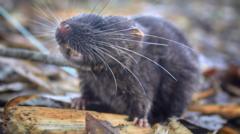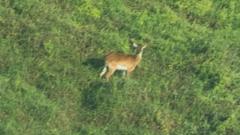Scientists from Conservation International, in collaboration with local indigenous groups, have unearthed 27 new species during an expedition in northern Peru's Alto Mayo region. With discoveries ranging from an amphibious mouse with webbed feet to various fish and butterflies, the findings emphasize the area's unique ecosystems and the importance of indigenous knowledge in conservation efforts.
27 New Species Discovered in Peru, Including Swimming Mouse and Unique Fish

27 New Species Discovered in Peru, Including Swimming Mouse and Unique Fish
A recent expedition in the Alto Mayo region of Peru has yielded 27 new species, including an amphibious mouse and a peculiar blob-headed fish, highlighting the rich biodiversity of the Amazon.
In an extraordinary scientific breakthrough, experts have discovered 27 new species in the Alto Mayo region of Peru, known for its rich biodiversity and conservation value. Among the notable findings are an amphibious mouse with webbed feet, dubbed the "swimming mouse," and a newly identified blob-headed fish, both of which reflect the unique adaptations of species in this vibrant Amazonian ecosystem.
The discoveries were made during a scientific expedition led by Conservation International, in partnership with local indigenous groups. This collaborative effort aims to enhance the understanding of biodiversity in the Alto Mayo region, which faces environmental pressures such as deforestation and agricultural expansion due to its relatively high population density.
"To uncover so many new species of mammals and vertebrates in such a heavily impacted area is remarkable," commented Trond Larsen, Senior Director at Conservation International. The expedition revealed not only the amphibious mouse but also a new dwarf squirrel, eight types of fish, three amphibian species, and ten new butterfly varieties, illustrating the ecological richness preserved within this protected area.
One particularly intriguing specimen, a fish with an unusually enlarged head, was already familiar to the Indigenous Awajún people who participated in the study. Their traditional knowledge proved invaluable, stating that the reported findings empower the Awajún community to better protect and manage their cultural and natural resources.
The newly discovered dwarf squirrel is a small and fast creature, measuring just 14 centimeters, half the length of an average grey squirrel found in the UK. This tiny mammal's charming chestnut-brown coloration makes it an endearing addition to the region's fauna. Alongside it, a new spiny mouse was identified, known for its stiff guard hairs that mimic the protective spines of hedgehogs.
Moreover, the expedition revealed a unique arboreal opossum species with large ears and remarkable hearing abilities and a climbing salamander that was previously abundant in a specific white sand patch.
These groundbreaking discoveries emphasize both the ecological significance of the Alto Mayo region and the critical role of indigenous knowledge in conservation efforts, illustrating the need to preserve these unique ecosystems for future generations.

















